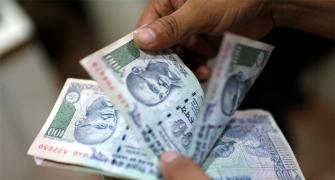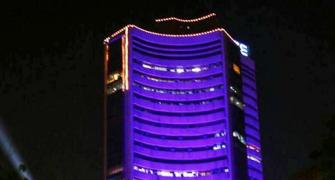Amid a grim global scenario, India will have to labour hard to hold on to seven per cent growth in 2016-17, says Omkar Goswami.
 The world is seeing a clear split. The US is performing very well while the rest of the developed world and most emerging markets are struggling.
The world is seeing a clear split. The US is performing very well while the rest of the developed world and most emerging markets are struggling.
US gross domestic product (GDP) growth for 2015 will be 2.5 per cent - higher than that of Canada, Britain and the entire euro area.
Unemployment is at a low of five per cent; the current account deficit is below 2.5 per cent of GDP; manufacturing is trotting along; and the housing market is better than in the last seven years.
The US is the exception. Thus the US Federal Reserve's 25-basis-point rate hike last year; and why Stanley Fischer, an outstanding macroeconomist and vice-chairman of the US Federal Reserve, said on January 6 that four Fed rate hikes were "in the ballpark" for 2016.
Not so for the euro area: Growth for 2015 will be 1.5 per cent. The unemployment rate is 10.5 per cent. Budget deficits of France and Spain exceed four per cent of GDP.
François Hollande of France has declared an economic emergency, whatever that means. No wonder Mario Draghi, president of the European Central Bank, is determined to keep interest rates at an all-time low.
Regrettably, a low interest rate regime is at best a necessary condition for fuelling growth. The euro area has none of the sufficient conditions.
Brazil and Russia are in the doldrums. In July-September 2015, Brazil's GDP shrank 6.7 per cent on an annualised quarter-to-quarter basis.
Consumer inflation is at 11 per cent; the currency has tanked 66 per cent in a year; yield on 10-year government bonds exceeds 16 per cent; the budget deficit is six per cent of GDP; and the current account deficit is in perilous territory.
Henry Kissinger once called Russia a basket case with nuclear weapons. It sounds true today. Deprived of revenues from minerals, oil and gas, and with no other significant sectors worth speaking of, Russia's GDP will shrink 3.8 per cent in 2015.
Inflation reigns at over 15 per cent; the real yield on 10-year government bonds is at minus five per cent; and the rouble is at 77 to the US dollar -much worse than the rupee and a far cry from 30 some 24 months ago.
On to China. The country's slogan of "Maintain 8" has been reduced to "Maintain 7". Even that has not happened with a GDP growth of 6.9 per cent in 2015, the slowest in 25 years. The number is suspect.
For 2016, GDP growth is expected to reduce to 6.6 per cent. Demand is slowing; manufacturing inventories are rising; corporate debts as well as bad loans are at an all-time high; despite currency controls, the yuan is unpredictably volatile; and the government is struggling to steer the economy from over-investment to consumption.
Make no mistake: China continues to do well by international standards. But when a Lamborghini becomes a Lambretta, the world shivers.
Why does all this foretell poorly for India in 2016? First, the international perspective.
When over two-thirds of the global economy is in serious trouble, it is foolhardy to expect a leading emerging market to enjoy immunity.
Stock prices will trend downwards, often buffeted nastily. Between January 27, 2015, and January 18, 2016, the Sensex fell by over 18 per cent. Expect more. The rupee (INR) will depreciate.
A year ago, the INR was at 61.6 to the US dollar (USD). It has fallen 8.6 per cent to 67.7. It should continue to fall - pulled down by a global move to US Treasury bills.
My guess is the INR would be somewhere between 75 and 77 to the USD. Unfortunately, that won't help exports because our manufacturing remains weak, our logistics terrible and ports pathetic.
Second, banking. According to the Reserve Bank of India (RBI), the gross non-performing assets ratio was 5.1 per cent for the first half of 2015-16. That's around Rs 65,000 crore.
It will deteriorate further by the end of March 2016, to reach the worst it has been for long.
Banks are loathe to fix this because of unbearable strains on their accounts. Large corporate defaulters have taken cover under dysfunctional bankruptcy laws and procedures.
The new Insolvency and Bankruptcy Bill is yet to be passed. Even when that happens, it will take a few years for the requisite institutions to come to bear and create a credible bankruptcy process.
Till then, large debtors will run riot; the RBI will issue stern warnings; and banks will squeamishly wring their hands. The outcome: Good projects will be starved of funds.
Third, infrastructure. Despite huge budgetary allocations, there is a distinct lack of pace across various projects. Although highways have picked up speed, it is not good enough.
On November 30, 2015, 14,021 km under the National Highways Authority of India -or 29 per cent of the road length - had not yet been awarded. Many large thermal power projects remain stuck.
There is no discernible uptick in demand for steel, cement, bitumen or asphalt to suggest that infrastructure is back on track.
The only good news is crude oil prices. Now running at under USD 27 per barrel, it has dramatically helped our balance of payments and will keep the fiscal deficit to the budget estimate of 3.9 per cent of GDP.
Great for the exchequer, but this hasn't yet translated into any discernible growth in either manufacturing, construction or services output.
For that to happen, there must be a major infusion of affordable credit, which doesn't seem likely given the stressed state of most banks.
So, for the present, dreams about eight to 8.5 per cent growth will remain exactly as they are - dreams. Expect GDP growth to be around 7.3 per cent for 2015-16, with a distinct possibility of trending down to seven or 7.1 per cent in 2016-17.
Several banks will need to be recapitalised, which will put a strain on the exchequer. Infrastructure will shuffle along, perhaps faster than before, but not quick enough. And it will take another two to three quarters before manufacturing picks up.
Let us hope that it isn't worse than what I think. Because it could well be.
The author is an economist and chairman of CERG Advisory Pivate Limited.










